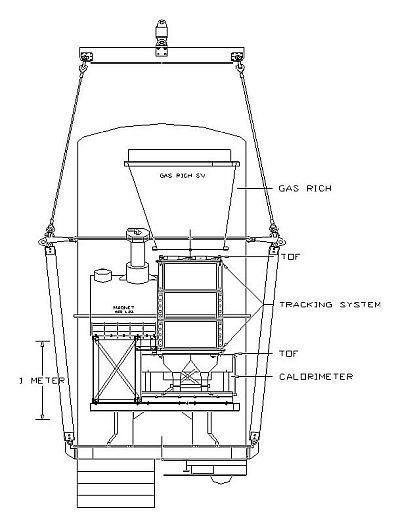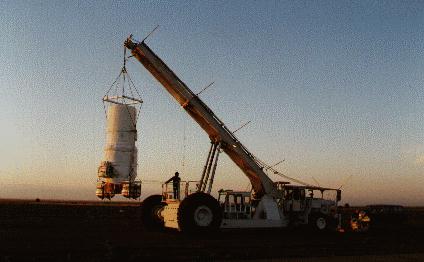Purpose of the flight and payload description
CAPRICE-2 was the acronym of Cosmic AntiParticle Ring Imaging CherEnkov an instrument developed under the Wizard collaboration programme between New Mexico State University (USA), Goddard Space Flight Center (USA), INFN (Italy), University of Siegen (Germany), CRN Strasbourg (France) and KTH Stockholm (Sweden). The group was was formed to bring together the experience of cosmic ray research conducted with balloons of the US groups, with the knowledge of particle detectors of the European groups. This was an upgraded version of the experiment flown in 1994 by the same group. Main modification was the replacement of the solid RICH detector, by a gas RICH detector and the replacement of the Multi Wire Proportional Chambers in the magnet spectrometer with a third drift chamber. The experimental goal of the CAPRICE-2 experiment was the measurement of antiprotons, electrons and positrons at 4~30 GeV.
At left we can see an scheme of the instrument (click to enlarge). The apparatus included from top to bottom: a Gas Ring Imaging Cherenkov (RICH) detector, a time-of-flight (TOF) system, a superconducting magnet spectrometer equipped with drift chambers (DC) and a silicon-tungsten imaging calorimeter.
The RICH detector consisted ofa 1m tall gas radiator, filled with high purity C4F10 gas. The Cherenkov light produced in the gas was reflected by a spherical mirror, located at the bottom of the vessel, onto a multiwire proportional chamber (MWPC) filled with ethane to which was added the photosensitive agent TMAE (tetrakis-dimethyl-amino-ethylene). The photoelectron signals from the multiwire chamber were collected by 8 x 8 mm2 pads in the 51 x 51 cm2 pad plane to measure the velocity of the particles.
The time-of-flight system was used to make a trigger, to determine the particle velocity from the time of flight, and its energy loss (dE/dx) in the scintillators. This system eliminated all upward-going particles, selected charge 1 particles (for the muon analysis), and was used for particle identification at lower momenta. The TOF resolution was about 230 ps.
The spectrometer consisted of a superconducting magnet and a tracking device equipped with three sets of drift chambers. The magnet consisted of a single coil of 11.161 turns of copper-clad NbTi wire. The outer diameter of the coil was 61 cm and the operating current was 120 A, producing an inhomogeneous field of about 4 Tesla at the center of the coil. The chambers provided 18 position measurements in the direction of maximum bending and 12 along the perpendicular direction. Particle rigidities were determined using the knowledge of the bending of the track and the field along the track. The maximal detectable rigidity was 300 GV.
The electromagnetic calorimeter consisted of eight 48 x 48 cm2 planes of silicon strip (3.6 mm wide) detectors with both X and Y readouts. These silicon planes were interleaved with layers of tungsten converters, each one radiation length thick. Taking into account all the material, the calorimeter had a total thickness of 7.2 radiation lengths and 0.33 nuclear interaction lengths. The calorimeter provided topological information on both the longitudinal and lateral profiles of the particle's interaction as well as a measure of the total energy deposited in the calorimeter.
All these elements were installed inside a thermally insulated aluminium pressure vessel mounted on a strong baseplate. The structure (a.k.a. the gondola) was 4 meters high, has a diameter of 1.5 meters and weighted approximately 2.100 kgs. It was painted white to reflect sun light helping to balance the heat generated by the electronics in the payload and the irradiation from the Sun and the Earth, with the outside temperature. Power during the flight was supplied by lithium batteries mounted on the outside of the gondola. For a 24 hour long flight with an average power consumption of 1.5 kW it required 180 kg of batteries. When the flight was terminated, the gondola was detached from the balloon and landed with a parachute. To reduce the impact (a 5 g force) upon landing, a crash pad was mounted underneath the gondola. On the sides of the gondola were attached two ballast containers which were operated by telecommand to counteract the lose of altitude of the balloon at night.
Details of the balloon flight
Balloon launched on: 5/24/1997 at 13:24 utc
Launch site: Scientific Flight Balloon Facility, Fort Sumner, (NM), US
Balloon launched by: National Scientific Balloon Facility (NSBF)
Balloon manufacturer/size/composition: Zero Pressure Balloon Raven 39.570.000 cuft - 40H
Balloon serial number: W39.57-3-09
Flight identification number: 433N
End of flight (L for landing time, W for last contact, otherwise termination time): 5/24/1997 at 17:31 utc
Balloon flight duration (F: time at float only, otherwise total flight time in d:days / h:hours or m:minutes - ): 5 h
Landing site: 13 miles of Corona, New Mexico, US
Payload weight: 7788 lbs
The CAPRICE-2 experiment was launched from Fort Sumner, New Mexico at 13:24 utc on the morning of May 14, 1997. However, after five hours aloft the balloon flight was terminated earlier than expected due to a failure in the gondola of the experiment. No scientific data was obtained. The mission would be completed succesfuly on May 28, 1998.
External references
- CAPRICE website University of Siegen, Germany (via Archive.Org)
- NASA Balloon Flights (1989-1998) in NASA Historical Data Book, Vol. VII: NASA Launch Systems, Space Transportation, Human Spaceflight, and Space Science, 1989-1998
642If you consider this website interesting or useful, you can help me to keep it up and running with a small donation to cover the operational costs. Just the equivalent of the price of a cup of coffee helps a lot.



